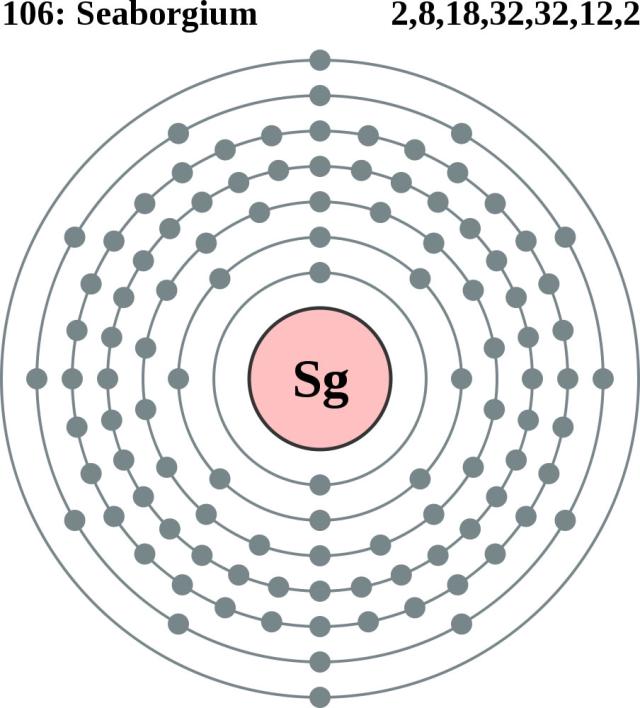Math Is Fun Forum
You are not logged in.
- Topics: Active | Unanswered
Pages: 1
#1 Yesterday 22:45:45
- Jai Ganesh
- Administrator

- Registered: 2005-06-28
- Posts: 52,197
Seaborgium
Seaborgium
Gist
Seaborgium (Sg) is a synthetic, radioactive chemical element with atomic number 106. It is a highly unstable, man-made element named after American chemist Glenn T. Seaborg. While its properties are not fully known due to its extreme instability, it is predicted to be a metal similar to tungsten, with no natural occurrence or commercial applications.
Seaborgium has no current commercial or practical applications because it is a highly radioactive synthetic element with a very short half-life. Its only use is for scientific research, primarily to study its physical and chemical properties and to help synthesize other superheavy elements.
Summary
Seaborgium is a synthetic chemical element; it has symbol Sg and atomic number 106. It is named after the American nuclear chemist Glenn T. Seaborg. As a synthetic element, it can be created in a laboratory but is not found in nature. It is also radioactive; the most stable known isotopes have half-lives on the order of several minutes.
In the periodic table of the elements, it is a d-block transactinide element. It is a member of the 7th period and belongs to the group 6 elements as the fourth member of the 6d series of transition metals. Chemistry experiments have confirmed that seaborgium behaves as the heavier homologue to tungsten in group 6. The chemical properties of seaborgium are characterized only partly, but they compare well with the chemistry of the other group 6 elements.
In 1974, a few atoms of seaborgium were produced in laboratories in the Soviet Union and in the United States. The priority of the discovery and therefore the naming of the element was disputed between Soviet and American scientists, and it was not until 1997 that the International Union of Pure and Applied Chemistry (IUPAC) established seaborgium as the official name for the element. It is one of only two elements named after a living person at the time of naming, the other being oganesson, element 118.
Details
Seaborgium (Sg) is an artificially produced radioactive element in Group VIb of the periodic table, atomic number 106. In June 1974, Georgy N. Flerov of the Joint Institute for Nuclear Research at Dubna, Russia, U.S.S.R., announced that his team of investigators had synthesized and identified element 106. In September of the same year, a group of American researchers headed by Albert Ghiorso at the Lawrence Radiation Laboratory (now Lawrence Berkeley Laboratory) of the University of California at Berkeley reported their synthesis of the identical element. Disagreement arose between the two groups over the results of their experiments, both having used different procedures to achieve the synthesis. The Soviet scientists had bombarded lead-207 and lead-208 with ions of chromium-54 to produce an isotope of element 106 having a mass number of 259 and decaying with a half-life of approximately 0.007 second. The American researchers, on the other hand, had bombarded a heavy radioactive target of californium-249 with projectile beams of oxygen-18 ions, which resulted in the creation of a different isotope of element 106—one with a mass number of 263 and a half-life of 0.9 second. Russian researchers at Dubna reported their synthesis of two isotopes of the element in 1993, and a team of researchers at Lawrence Berkeley duplicated the Ghiorso group’s original experiment that same year. In honour of the American nuclear chemist Glenn T. Seaborg, American researchers tentatively named the element seaborgium, which was later ratified by the International Union of Pure and Applied Chemistry. Based on its position in the periodic table, seaborgium is thought to have chemical properties akin to those of tungsten.
Additional Information:
Appearance
A radioactive metal that does not occur naturally. Only a few atoms have ever been made.
Uses
At present, it is only used in research.
Biological role
Seaborgium has no known biological role.
Natural abundance
Seaborgium is a transuranium element. It is created by bombarding californium-249 with oxygen-18 nuclei.

It appears to me that if one wants to make progress in mathematics, one should study the masters and not the pupils. - Niels Henrik Abel.
Nothing is better than reading and gaining more and more knowledge - Stephen William Hawking.
Offline
Pages: 1